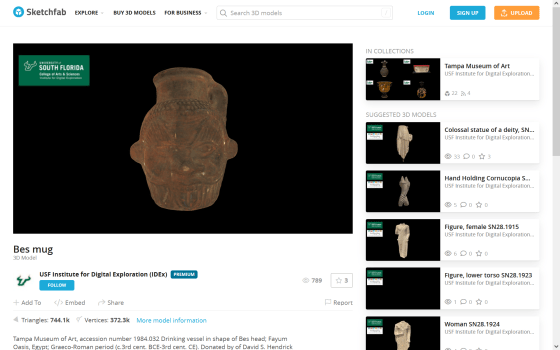Egyptians may have drunk cocktails of bodily fluids and hallucinogens during ancient rituals, study finds

Analysis of a mug believed to have been used by an ancient Egyptian revealed that it contained ingredients from plants that would be considered hallucinogens today, in addition to alcohol. It has been suggested that the drink was consumed by those seeking divine intervention to enter a trance-like state.
Multianalytical investigation reveals psychotropic substances in a ptolemaic Egyptian vase | Scientific Reports
Study confirms Egyptians drank hallucinogenic cocktails in ancient rituals
https://phys.org/news/2024-11-egyptians-drank-hallucinogenic-cocktails-ancient.html
In ancient Egypt, a god called ' Bes ' was worshiped. Bes was said to protect people from danger, avoid harm, and ward off evil with his power. In a crisis, Bes gave the bloodthirsty goddess Hathor an alcoholic drink disguised as blood, putting her into a deep sleep of oblivion.
He was also spoken of as a god of dreams, a bringer of joy, and a being in charge of masculinity and sexual desire, fertility and fecundity, as well as childbirth and growth, and a kind of 'rebirth.'
Below is a recreation of Beth based on various sources.

by
The worship and rituals of Bes were passed down over the centuries, though in different forms. In particular, during the Ptolemaic period (around 330 BC to 30 AD) or even earlier, a 'Chamber of Bes' was built in the ruins of Saqqara near the Egyptian capital of Memphis, where rituals were held.
One of the ritual objects excavated in connection with Bes is the 'Bes vases.' Bes vases are a type of pottery decorated with a portrait or head of Bes, and were in circulation in Egypt from the New Kingdom period (1570 BC - 1070 BC) through the Hellenistic period (336 BC - 30 BC), when production reached its peak, and through the Roman Empire period (30 BC - 476 AD).

As such, the Vase of Bes existed under various circumstances across multiple eras, making it extremely difficult to guess whether it was used for everyday purposes or for religious ceremonies. However, by examining one of the existing 'Vases of Bes' that is believed to have been used around the 2nd century BC, the ingredients contained in the jar have been identified.
Davide Tanasi of the University of South Florida and his colleagues collected particle samples from Bess's Jar, which is kept at the Tampa Museum of Art in Tampa, Florida, and performed spectroscopic and mass spectrometry analysis on them. They found traces of royal jelly, wheat, sesame, wine, high-sugar honey or fruit, as well as a complex concoction of drugs.
Prominent among the concoctions was the medicinal plant Peganum harmala, commonly known as harmala or Syrian rue, which contains alkaloids that induce dreamlike hallucinations and are now known as
The ancient Greek and Roman cult of Bes included a ritual for oracle purposes, in which a client would sleep in a 'Bes room' to receive prophetic dreams, so Thanasi and his colleagues speculated that the hallucinogenic properties of the stone would make it well suited to such purposes.
Further evidence supporting the link between Bes, Peganum harmala, and hallucinogenic properties includes inscriptions found in the temple of Seti I, who ruled Ancient Egypt from 1294 to 1279 BC, which indicate that Bes was called the 'giver of oracles' and 'giver of dreams.' At least 12 figurines of Bes have been found, depicting her emerging from a water lily, the seeds of which are believed to have narcotic and sedative properties.
Linguistically, the various names for harmala, both ancient and modern, from baššāšā (Ancient Syria), baššūšā (Modern Syria), bešaš (Ancient Aramaic), basous (Coptic), bêsasa (Modern Egyptian), and bêsa (Greek medical papyrus), all have roots consisting of the letters 'bs-' and 'bss-', suggesting a connection to Bes. In particular, the names bêsa and bêsasa are directly derived from Bes and are interpreted as 'plant of Bes.'

Other plants found in Bess's Jar include Cleome gynandra L., which can either induce labor or have an abortifacient effect depending on the amount used, and Cleome chrysantha Decne, which is traditionally used as an anthelmintic and for treating infantile convulsions. Proteins found in the particles also suggest that human bodily fluids, such as breast milk, mucus (oral or vaginal), or blood, may have been intentionally added to the drink.
Based on this information, Tanasi and his colleagues point out that the people who sought oracles were mainly pregnant women, and that in the ancient world, where pregnancy and childbirth were fraught with danger, it is possible that people who wanted to be sure of the success of their pregnancy underwent hallucination-inducing rituals in the 'Chamber of Bes.'
'We can conclude that these plants were intentionally used in rituals to induce psychoactive effects,' said Tanasi and his colleagues. 'Our study sheds light on an ancient Egyptian mystery: how the Vase of Bes was used almost 2,000 years ago.'
In addition, a 3D model of the Bess vase preserved at the Tampa Museum of Art can be viewed at the following site.
Bes mug - 3D model by USF Institute for Digital Exploration (IDEx) (@usfidex) [49935b7]

Related Posts:
in Posted by log1p_kr







